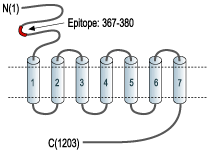Overview
- Peptide EGFAQENSKYNKTC, corresponding to amino acids 367-380 of rat mGluR5 (Accession P31424). Extracellular, N-terminus.

 Western blot analysis of rat brain (lanes 1 and 3) and mouse brain (lanes 2 and 4) lysates:1,2. Guinea pig Anti-mGluR5 (extracellular) Antibody (#AGC-007-GP), (1:400).
Western blot analysis of rat brain (lanes 1 and 3) and mouse brain (lanes 2 and 4) lysates:1,2. Guinea pig Anti-mGluR5 (extracellular) Antibody (#AGC-007-GP), (1:400).
3,4. Guinea pig Anti-mGluR5 (extracellular) Antibody, preincubated with mGluR5 (extracellular) Blocking Peptide (#BLP-GC007).
Following a broad screen of secondary antibodies, the following were used for this application:
#106-035-006 (Jackson ImmunoResearch)
#A7289 (Sigma)
- Dore, A.S. et al. (2014) Nature. 511, 557.
- Chen, C. et al. (2012) Neurosci. Lett. 524, 65.
- Cleva, R.M. and Olive, M.F. (2011) Molecules 16, 2097.
Metabotropic glutamate G protein-coupled receptors are divided into three groups on the basis of their sequence similarity, pharmacology and signal transduction mechanisms. mGluR5 is a class I mGlu receptor and is widely expressed throughout the cortex, hippocampus, striatum, caudate nucleus and nucleus accumbens, areas involved in emotion, motivation and cognition. mGluR5 is primarily located post-synaptically and is coupled to the Gq/11 pathway.
mGluR5 is comprised of an extracellular N-terminus, an intracellular C-terminus and seven transmembrane α helices (TM1–7). Native ligands can bind to the receptor’s extracellular domain. This extracellular binding is consistent with the narrow allosteric pocket the receptor possesses due to the tight configuration of its helical bundle1. mGluR5 is physically coupled to NMDA receptors by various scaffolding proteins including PSD-95, Shank, and Homer, as well as via a direct interaction. In addition, mGluR5 is biochemically coupled to NMDA receptor function via PKC. As a result of these molecular and biochemical interactions, activation of mGluR5 results in enhanced functionality of the NMDA receptor.
mGluR5 is also involved in dendrogenesis and spineogenesis. mGluR5−/− knockout mice exhibit elevated spine densities irrespective of spine type or location along their dendritic trees in comparison to mGluR5+/− animals2.
Recent studies have shown that mGluR5 is a critical mediator and a potential therapeutic target for the treatment of numerous disorders of the central nervous system, including depression, anxiety, drug addiction, chronic pain, Fragile X syndrome, Parkinson’s disease, and gastroesophageal reflux disease3.
Application key:
Species reactivity key:
Alomone Labs is pleased to offer a highly specific antibody directed against an epitope of rat mGluR5. Guinea pig Anti-mGluR5 (extracellular) Antibody (#AGC-007-GP), raised in guinea pigs, can be used in western blot analysis. It has been designed to recognize mGluR5 from mouse, rat, and human samples. The antigen used to immunize guinea pigs is the same as Anti-mGluR5 (extracellular) Antibody (#AGC-007) raised in rabbit. Our line of guinea pig antibodies enables more flexibility with our products such as multiplex staining studies, immunoprecipitation, etc.
